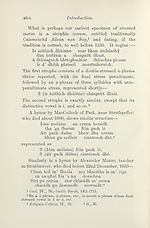Download files
Complete book:
Individual page:
Thumbnail gallery: Grid view | List view

Introduction.
xlvii.
In the old strophie metre called. Ochtfhoclach mor
(great eight-phrased poetry) the longer lines end on
dissyllables: (3 x 62) + 51- The following example is
from the Book of Leinster, compiled c. 1150, but the
verse is older:— Cid Domnall na Carpre
na Niaman an airgne,
eid iat lucht na bairddne
rot fiat-su cen acht.
Fonaisc latt ar Morand,
mad aill leat a- chomall,
naisc Carpre min Manand
is naisc ar d& mac.1
The next example shows this measure applied to a
labour chant, in this case an Oran Brathann,
quern-song. ajg mo ghuilean
Thug eaZlach dhiom is duiseal,
’S tha m’ aire nis air sitgradh
Le cuirteir nam flath.
Tha m’ fhaireachadh air dttsgadh,
Cha chaiZZeach ach bean ur mi,
Mo ghean air aiseag Ittis dhomh
S mo run air an t-srath.a
1 (Meave, Queen of Connacht, speaks to the hero Ferdiad, to
whom she has made certain offers, for the fulfilment of which he
demands pledges). “Though it be Domnall or Carpre, or brilliant
wide-spoiling Niaman, though it be the folk of poesy, thou shalt
have them without hesitation. Bind it in thy interest on Moran,
if thou wilt have it fulfilled, bind Carpre of the smooth of Manau,
and bind our two sons.” Af/ti Manand was in Connacht; com¬
pare the old province of Manau, about the head of the Firth of
Forth, whence Slamannan=Sliahh Manann, and Clackmannan
= Clock Manann.
2 Macdonald Collection, p. 334. The poem begins—
Brath, brath, bleith, 0, brath, brath, bleith,
like the Greek grinding-chant—
S\ei, /xuXa, SXet
“Grind, thou mill, grind.” It is by far the most remarkable
of our quern-songs. Miss Frances Tolmie gives the words and air
of a waulking-song which is evidently closely connected.—Folk-
Song Journal, No. 16, p. 228.
xlvii.
In the old strophie metre called. Ochtfhoclach mor
(great eight-phrased poetry) the longer lines end on
dissyllables: (3 x 62) + 51- The following example is
from the Book of Leinster, compiled c. 1150, but the
verse is older:— Cid Domnall na Carpre
na Niaman an airgne,
eid iat lucht na bairddne
rot fiat-su cen acht.
Fonaisc latt ar Morand,
mad aill leat a- chomall,
naisc Carpre min Manand
is naisc ar d& mac.1
The next example shows this measure applied to a
labour chant, in this case an Oran Brathann,
quern-song. ajg mo ghuilean
Thug eaZlach dhiom is duiseal,
’S tha m’ aire nis air sitgradh
Le cuirteir nam flath.
Tha m’ fhaireachadh air dttsgadh,
Cha chaiZZeach ach bean ur mi,
Mo ghean air aiseag Ittis dhomh
S mo run air an t-srath.a
1 (Meave, Queen of Connacht, speaks to the hero Ferdiad, to
whom she has made certain offers, for the fulfilment of which he
demands pledges). “Though it be Domnall or Carpre, or brilliant
wide-spoiling Niaman, though it be the folk of poesy, thou shalt
have them without hesitation. Bind it in thy interest on Moran,
if thou wilt have it fulfilled, bind Carpre of the smooth of Manau,
and bind our two sons.” Af/ti Manand was in Connacht; com¬
pare the old province of Manau, about the head of the Firth of
Forth, whence Slamannan=Sliahh Manann, and Clackmannan
= Clock Manann.
2 Macdonald Collection, p. 334. The poem begins—
Brath, brath, bleith, 0, brath, brath, bleith,
like the Greek grinding-chant—
S\ei, /xuXa, SXet
“Grind, thou mill, grind.” It is by far the most remarkable
of our quern-songs. Miss Frances Tolmie gives the words and air
of a waulking-song which is evidently closely connected.—Folk-
Song Journal, No. 16, p. 228.
Set display mode to:
![]() Universal Viewer |
Universal Viewer | ![]() Mirador |
Large image | Transcription
Mirador |
Large image | Transcription
| An Comunn Gàidhealach > An Comunn Gàidhealach Publications > Bardachd Ghaidhlig > (51) |
|---|
| Permanent URL | https://digital.nls.uk/126281744 |
|---|
| Description | This contains items published by An Comunn, which are not specifically Mòd-related. It includes journals, annual reports and corporate documents, policy statements, educational resources and published plays and literature. It is arranged alphabetically by title. |
|---|
| Description | A collection of over 400 items published by An Comunn Gàidhealach, the organisation which promotes Gaelic language and culture and organises the Royal National Mòd. Dating from 1891 up to the present day, the collection includes journals and newspapers, annual reports, educational materials, national Mòd programmes, published Mòd literature and music. |
|---|---|
| Additional NLS resources: |
|

